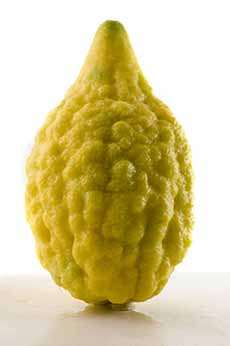FOOD 101: What’s An Etrog?
|
|
Recently, we encountered a fruit we’d not heard of before: the etrog, a species of citron that looks like a bumpy lemon. Then we discovered that it’s something with which we were quite familiar: citron, the fruit with a very fragrant rind that’s candied and used in baking. Etrog = citron. It’s the Hebrew word for it*. Etrog has a delightful lemon scent and flavor, though most of it comes from the peel. There is little flesh inside (photo #3), although what there is provides juice. Etrog (EH-trog*), Citrus medica, is a member of the citrus family, Rutaceae. But it’s a different species from grapefruits, lemons, limes, mandarins and oranges. Etrog is one of for species of citron: the yellow citron, used by Jews during the week-long holiday of Sukkot† in holiday rituals is the yellow citron or Citrus medica etrog for the performance of the Sukkot (October 2-9, 2020). Here’s a summary of how etrog is used in the celebration of Sukkot. Unlike the other fruit trees of the Holy Land—date, fig, grape and pomegranate, for example—etrog required intense irrigation. It is a fragile crop: difficult to grow and delicate to handle and ship; both of which are reflected in the high price. Even historically, the fruit was exotic and costly (as it remains today). Today, etrog is largely grown in Israel, Italy and Morocco. In the U.S., they are grown at Pearson Ranch in California, where the season can vary but is typically September through June. Citron syrup can be used as a condiment or mixed into sparkling water, and as a sweetener for tea and cocktails. Using The Pith The white pith is the sweetest part of the fruit. Botanical historians have found the roots of etrog in the Far East. It was carried westward, by unknown traders and travelers as well as Alexander the Great, who carried it with his stores throughout the Mediterranean region. In 332 B.C.E., “it was well-rooted as the first citrus fruit in the western world” [source]. Etrog was described in detail by the great Greek naturalist Theophrastus, a contemporary of Alexander. He extolled it for its medicinal value as well as its fragrance. There is evidence of etrogs appearing in Jerusalem as early as the 7th century B.C.E. [source]. Etrog seeds have been found in Mesopotamian excavations dating back 6,000 years. There is evidence of cultivated in the Jerusalem region in the second century B.C.E. Pollen from the etrog was found in an excavation; the archaeologists speculate that the fruit was brought there from India via Persia. Etrog appeared in the Peloponnesus in southern Greece, and Mauritania, in the first and second centuries. It then dispersed to Lebanon, Syria, Greece and Italy. From Israel it traveled to Northern Africa: Egypt, Libya, Tunisia and Morocco. But why would a fruit with almost no pulp, that needs copious quantities of water and care, and that is particularly fragile, be grown in orchards in the Mediterranean region? |
|
|
For one, it was required for religious reasons, as commanded in the Torah. Etrogs have been used in Sukkot religious rituals since at least the second century B.C. E. [source]. And then, it was for perceived medicinal value. Historically, etrog has been used to treat muscular pain, seasickness and skin disease. In India, the peel is still eaten to remedy bad breath. In Panama, citron leaves are ground up and combined with other ingredients as an antidote for poison These and other medicinal uses explain why etrog is classified as Citrus medica. ________________ *Etrog is Sephardic Hebrew, plural etrogim. In Ashkenazi Hebrew it is esrog, plural esrogim. †Sukkot is commonly translated as Feast of Tabernacles, Festival of Shelters, and Feast of Ingathering. It is a biblical Jewish holiday celebrated on the 15th day of the seventh month of the Israeli calendar, Tishrei. ‡One etrog variety has very small juice sacs in the center, although the giant Yemenite etrog has no juice inside at all. Etrog cultivars include Diamante (Yanaver), which is acid and seedy, grown in Calabria; Assads, which is acidless and often seedless, grown in Morocco; Israeli selections such as Braverman, Halperin and Lefkovich, and Kibilevitch, which are acid and seedy; and Yemen (Temoni), which has seeds but no juicy flesh, and originated in Yemen [source]. |
||






